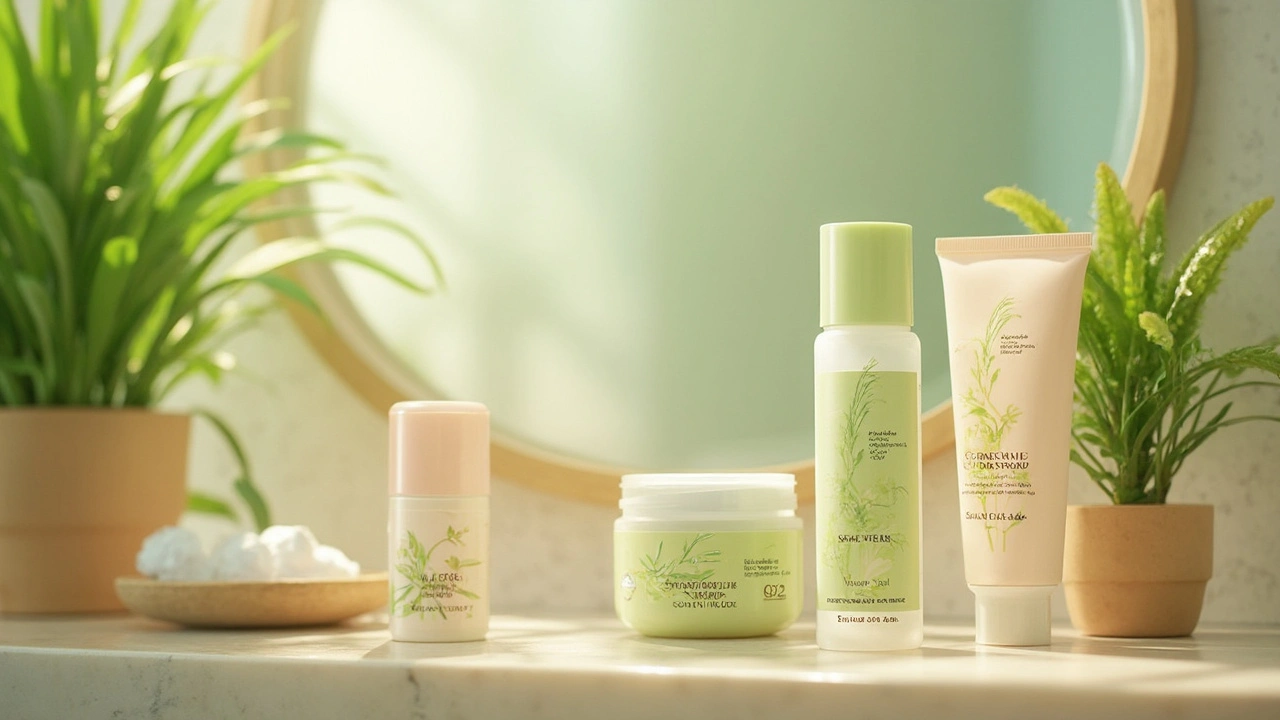Mottled skin discoloration might sound complicated, but it's simply about the uneven patches or spots we can see on our skin. These spots can vary in color and might sometimes confuse folks who are unsure whether it's just another skin quirk or something more.
Rosacea, on the other hand, is a chronic skin condition that often brings redness and sometimes pimples, primarily targeting the face. It's something that people mostly notice when someone has a flushed complexion or visible blood vessels.
Now, here's where it gets interesting: these two can be connected. When someone with rosacea experiences mottled skin, it's crucial to understand the underlying factors. Could it be changes in blood flow? Reaction to weather? Or maybe related to some dietary triggers?
What people really want to know is how to deal with these symptoms. Thankfully, there are ways to manage them effectively. Avoiding known triggers, using the right skincare products, and maybe even seeking professional help when needed. Simple changes can lead to significant improvements.
- What is Mottled Skin Discoloration?
- How is Rosacea Linked?
- Causes and Triggers
- Managing Symptoms Effectively
- Skincare Tips for Healthier Skin
What is Mottled Skin Discoloration?
Mottled skin discoloration might seem like a big, intimidating term, but it's just a way to describe those patchy, blotchy spots on your skin that aren't quite the same color as the rest. You've probably seen it—maybe even on your own skin—and wondered what it's all about.
This sort of discoloration usually involves red, purple, or even brownish patches. It's not one of those things that's picky about who it appears on; it can happen to anyone. What you see is a mix of blood vessels and pigmentation changes on the surface, often most noticeable on your arms and legs, but it can show up elsewhere too.
There are several reasons behind mottled skin discoloration. What's interesting is how it can link to other conditions, like rosacea. It also tends to emerge when the temperature shifts—like stepping out into the cold from a nice cozy room. When your blood vessels narrow and expand quickly, you might see that tell-tale mottling.
Of course, various health conditions can also lead to this kind of discoloration. Sometimes it's a sign of circulation issues or an autoimmune condition. However, don't jump to conclusions—having mottled skin doesn't guarantee one of these serious conditions. More often, it's perfectly harmless.
One useful thing to know is how lifestyle can play a role. Things like smoking or exposure to extreme weather conditions might make it more noticeable. Knowing what triggers your own skin reactions can be handy.
If we delve into data, studies have shown cases where about 20% of those examined with vascular sensitivity displayed some form of mottled skin discoloration. This tells us it's not uncommon at all, but still, when in doubt, a chat with a healthcare provider can clear things up.
How is Rosacea Linked?
The link between mottled skin discoloration and rosacea is more than just skin deep, and it goes beyond appearance. Both conditions involve similar changes that happen under the skin's surface. These changes often appear as redness and uneven patches, particularly on sun-exposed areas of the face.
At the heart of this connection lies the blood vessels. In rosacea, the blood vessels in the face tend to be more reactive and dilate easily, leading to increased redness and sometimes those pesky red lines known as telangiectasia. This vasodilation can contribute to the blotchy appearance that characterizes mottled skin discoloration.
Common triggers like extreme temperatures, spicy foods, or stress can worsen these symptoms. These triggers are known to activate the skin's immune responses, causing inflammation and promoting further discoloration.
Research has shown that about 50% of individuals with facial rosacea might experience eye-related symptoms such as dryness or irritation, commonly known as ocular rosacea, further proving the systemic nature of rosacea that goes beyond what we visibly observe. This systemic aspect might play a role in the linked skin changes as well.
- Sun exposure is a major factor; prolonged time under the sun without protection can exacerbate both conditions.
- Alcohol consumption, especially red wine, is well-known to cause flare-ups.
- It’s essential to choose skin products that soothe rather than irritate the sensitive skin associated with these conditions.
Understanding the connection between mottled skin discoloration and rosacea helps in crafting a better skincare regime, aiming not only to calm the skin but to prevent future aggravations.

Causes and Triggers
Understanding what causes mottled skin discoloration and how it's linked to rosacea can help manage and reduce symptoms. Both conditions can be triggered by various factors, and knowing these can make a world of difference.
One of the primary causes of mottled skin is changes in blood flow. When blood vessels dilate or constrict irregularly, it leads to those characteristic patches on the skin. This is quite common in people dealing with rosacea because their blood vessels are more sensitive and reactive.
Several triggers can worsen rosacea and mottled skin, including:
- Weather Conditions: Cold weather, wind, and sun exposure can all cause flare-ups. Protecting your skin with a scarf in winter or using a good sunscreen in summer is essential.
- Diet and Alcohol: Spicy foods, hot beverages, and alcohol are notorious for triggering both conditions. Keeping a food diary can help identify which items should be limited or avoided.
- Stress: High stress levels can cause skin to react more strongly. Stress management techniques like yoga, meditation, or even daily walks can be beneficial.
- Skincare Products: Using harsh products or those with alcohol can irritate the skin. Opt for those specifically designed for sensitive skin.
One helpful study involving 500 participants with rosacea found that 78% identified food as a trigger, cementing the link between diet and skin reaction. While avoiding triggers won't cure these conditions, it can significantly reduce the frequency and severity of the symptoms.
Overall, recognizing and managing the causes and triggers of mottled skin discoloration and rosacea can lead to healthier skin and better quality of life.
Managing Symptoms Effectively
Dealing with mottled skin discoloration and rosacea doesn’t have to be a lifelong struggle. A few smart strategies can make a world of difference in managing symptoms.
First things first, avoiding your known triggers is a biggie. Many people with rosacea notice that certain foods, like spicy dishes or hot drinks, make their skin flare up. Keeping a food diary can help pinpoint these troublemakers.
Secondly, let's talk about skincare. Being gentle with your skin is key. Look for products labeled as hypoallergenic or designed for sensitive skin. It’s a good idea to avoid anything with alcohol or fragrances, which can be irritating.
- Use a mild cleanser daily to remove dirt and sweat without stripping your skin of its natural oils.
- Moisturize regularly with a product that suits your skin type;
- Apply a broad-spectrum sunscreen daily. Sun exposure can worsen symptoms.
Consider lifestyle tweaks too. Stress reduction techniques, such as yoga or meditation, can be surprisingly effective since stress is a known trigger for skin issues.
Sometimes, despite all efforts, it helps to have professional guidance. Dermatologists might suggest topical or oral medications to calm severe symptoms. In some cases, procedures like laser therapy might be recommended.
Focusing on a proactive approach can keep symptoms more predictable and manageable. Everyone's skin is unique, so what works for one person might need adjustment for another. Experiment and see what your skin prefers.

Skincare Tips for Healthier Skin
When dealing with mottled skin discoloration and rosacea, picking the right skincare routine can make a real difference. The goal is to soothe the skin while minimizing flare-ups and irritation.
First off, let's talk about choosing a good cleanser. Opt for a gentle, fragrance-free cleanser. Harsh soaps can strip away natural oils, leading to more redness or flare-ups, especially in those with rosacea. Gentle doesn’t mean ineffective, so look for products that clean without causing trouble.
Next up, moisturizing is key. A lightweight moisturizer helps maintain the skin's natural barrier, which can prevent irritants from causing more harm. Aim for something with ingredients like ceramides or hyaluronic acid. These keep the skin hydrated without adding greasiness.
And how about protection? Sun exposure can worsen mottled skin discoloration and trigger rosacea, so a good sunscreen is a must. Find one that’s broad-spectrum and SPF 30 or above. Mineral sunscreens with zinc oxide are less likely to irritate sensitive skin.
Here’s a quick skincare routine to consider:
- Morning: Cleanse, moisturize, apply sunscreen.
- Evening: Cleanse thoroughly, apply a thicker nighttime moisturizer.
Avoiding triggers can save you a lot of hassle. Common ones include hot drinks, spicy foods, and alcohol. Noticing your triggers means you can avoid them and minimize outbreaks. Keeping a skincare diary can help identify these more clearly.
Sometimes, over-the-counter solutions aren't enough, and professional advice can provide more tailored solutions. Dermatologists might suggest specific treatments or medications that're appropriate for addressing your unique needs.
It's also a good idea to be patient. Changes don’t happen overnight. Regularly following a simple, gentle routine will bring improvements in time.


farhiya jama
March 28, 2025 AT 21:22Ugh, I’ve had this mottled skin crap since I was 16. Cold weather? Bye bye complexion. Spicy food? Instant lobster mode. I just wear long sleeves and pretend I’m a vampire. 😴
Astro Service
March 29, 2025 AT 18:01This is why America needs to ban alcohol and spicy food. We’re getting soft. Back in my day, we just toughed it out. No sunscreen, no ‘sensitive skin’ crap. Just grit and American pride. 🇺🇸
DENIS GOLD
March 30, 2025 AT 14:49Oh wow, another ‘skin care routine’ article. Next they’ll tell us to meditate and drink green tea while wearing silk pajamas. 🤡 I’ve got rosacea and I still lift 300 lbs. Your skin doesn’t need a therapist, it needs a punch.
Ifeoma Ezeokoli
April 1, 2025 AT 01:53Y’all, I’ve seen this on my grandma’s legs in Nigeria - she called it ‘the wind’s kiss’. It’s not always bad. Sometimes it’s just your body telling you it’s alive. 🌿 Don’t panic. Don’t over-treat. Just breathe, hydrate, and love your skin like it’s your first child. We’re all just trying to survive the weather, the stress, and the internet. ❤️
Daniel Rod
April 1, 2025 AT 07:00It’s wild how our skin reflects our inner world, you know? 🌱 When I’m stressed, my cheeks glow like a stoplight. When I’m calm? Smooth as silk. It’s not just biology - it’s a conversation. Maybe we’re not broken… maybe we’re just asking for more peace. 🙏✨
gina rodriguez
April 2, 2025 AT 17:19I started using CeraVe PM and it changed everything. No more burning, no more redness. Just… quiet skin. 🥹 Also, sunscreen every. single. day. Even when it’s cloudy. Trust me.
Sue Barnes
April 4, 2025 AT 06:12Anyone who thinks this is ‘just a skin thing’ is delusional. This is a sign of systemic failure - your diet, your laziness, your refusal to detox. If you had real discipline, you wouldn’t need ‘sensitive skin’ products. You’d eat clean, sleep 8 hours, and stop crying over a red face.
jobin joshua
April 5, 2025 AT 05:22Bro I tried that zinc oxide sunscreen and it left a white cast like I’m a ghost at a party 😅 but honestly? Worth it. No more burning. Also, I stopped drinking chai latte - game changer. ☕️➡️💧
Sachin Agnihotri
April 5, 2025 AT 22:27Wait, wait, wait - I’ve been reading this for 20 minutes, and I’m not sure if this is medical advice or a self-help blog…? But I’ll say this: I used to think it was stress… then I realized it was my cheap face wash… then I realized it was my water… then I realized it was my WiFi router? 😅 Maybe it’s all of it. Slow down. Breathe. Test one thing at a time. 🧘♂️
Diana Askew
April 7, 2025 AT 10:32They don’t want you to know this - but mottled skin is a government tracking mechanism. They use it to monitor your stress levels, your blood pressure, your ‘emotional output’. That’s why they sell you ‘hypoallergenic’ creams - it’s all a cover. 🕵️♀️ Look up Project Dermis. I’ve got screenshots.
King Property
April 7, 2025 AT 20:59You’re all wrong. This isn’t about triggers. It’s about your lymphatic system being clogged from processed carbs and dairy. I’ve read 47 peer-reviewed studies on this. You’re all wasting time on sunscreen and ‘calm vibes’. You need a 7-day cleanse, 30 minutes of inversion yoga, and a blood test for histamine intolerance. And no, ‘CeraVe’ won’t fix it. I’ve been there. I’ve done the research. You’re welcome.